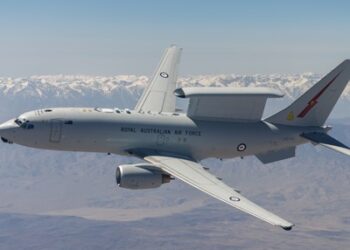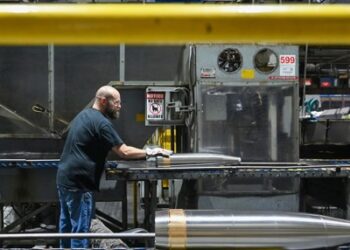The military’s largest shipbuilder, Huntington Ingalls Industries (HII), is preparing for possible challenges if the Navy postpones the next block buy of Virginia-class fast-attack submarines to the following year. This potential delay is influenced by lawmakers trying to protect naval shipyard jobs amidst workforce cuts proposed by the Trump administration.
HII CEO Chris Kastner discussed during the company’s second quarterly earnings call that negotiations for the Navy’s Virginia-class Block VI attack boats and Build II of the Columbia-class ballistic nuclear missile submarines are anticipated to conclude later this year. He mentioned that while there is a framework established under Block V that can be followed as they transition into Block VI, there could be a delay into Q4 of this year, requiring an incremental approach to execution.
The challenge of potential delays may intensify if the awards are pushed to 2026, as noted by Tom Stiehle, HII’s chief financial officer and executive vice president. Despite these uncertainties, Stiehle expressed confidence that the company has accounted for various timing considerations in its financial guidance.
Support for domestic shipbuilding has recently surged from the White House, Congress, and the Pentagon, with the Trump administration proposing around $47.4 billion in funding for shipbuilding. This funding is divided between the proposed base budget and one-time funds from reconciliation, aimed at bolstering the industrial base, which has faced difficulties in meeting heightened production demands, resulting in higher costs and scheduling delays in the Navy’s shipbuilding endeavors.
Bryan Clark, a senior fellow at the Hudson Institute, remarked that the reconciliation funding, which will be distributed over time, may help sustain production lines and ultimately enhance output. He suggested that moving procurement spending to reconciliation will create a backlog that companies can work from and enable investment in the supply chain.
HII reported $3.1 billion in revenue for the second quarter, along with a backlog of $56.9 billion and $11.9 billion in contract awards. These awards pertained to projects including Arleigh Burke-class guided missile destroyers, a San Antonio-class amphibious transport dock ship, and two Block V submarines featuring a weapons module upgrade. The company is targeting a 20 percent increase in throughput this year while also increasing wages and expanding operations at its Charleston facility, set to begin later this year.
Kastner stated that labor challenges are being addressed through wage increases and efforts to attract more experienced workers into the industry. He expressed a bullish outlook, maintaining a 4% growth revenue forecast and confidence in the rebuilding of the shipbuilding industrial base.
General Dynamics also reported a strong performance in its marine systems division, advertising a $53 billion backlog, including $18 billion in Virginia-class awards, which signifies an enhancement from the previous quarter. However, the naval shipbuilding sector has struggled with workforce challenges, leading to potential strikes and wage increases to recruit experienced workers.
Kastner indicated that early trends showed positive results in workforce attrition following recent wage increases at Newport News. While it’s early to celebrate success, the initial data appears optimistic for the workforce’s future stability.
In response to ongoing workforce reduction concerns, Congress is pursuing measures to bolster shipyard jobs. A bipartisan bill, introduced by Senators Jeanne Shaheen and Maggie Hassan of New Hampshire, alongside Senators Susan Collins and Angus King of Maine, aims to safeguard specific naval shipyard roles—like welding and nuclear maintenance—from cuts that could arise from the Trump administration’s workforce reduction strategies.
The bill seeks to ensure permanent exemptions from hiring freezes that were implemented earlier this year, with Senator Shaheen emphasizing that the Portsmouth Naval Shipyard workforce should be exempt but is facing challenges in enforcement. The proposed legislation intends to formalize these exemptions under federal law.
Meanwhile, the Trump administration is looking to invest in new technologies for 2026, with shipbuilders eager for these investments to yield significant returns. Clark noted that substantial funding is being directed towards development and scaling of next-generation capabilities, particularly in electronic warfare and cybersecurity.
HII’s Mission Technologies division demonstrated steady growth with $791 million in revenue for Q2, aligning its focus with Pentagon investments in diverse areas including drones and cybersecurity. The company has secured contracts to enhance the U.S. Army’s training capabilities and has established partnerships to improve shipbuilding processes via artificial intelligence.
Overall, HII is poised to explore opportunities in the unmanned vehicle sector, both underwater and on the surface, with Kastner indicating strong potential for new programs that could serve as beneficial factors for the company moving forward.













